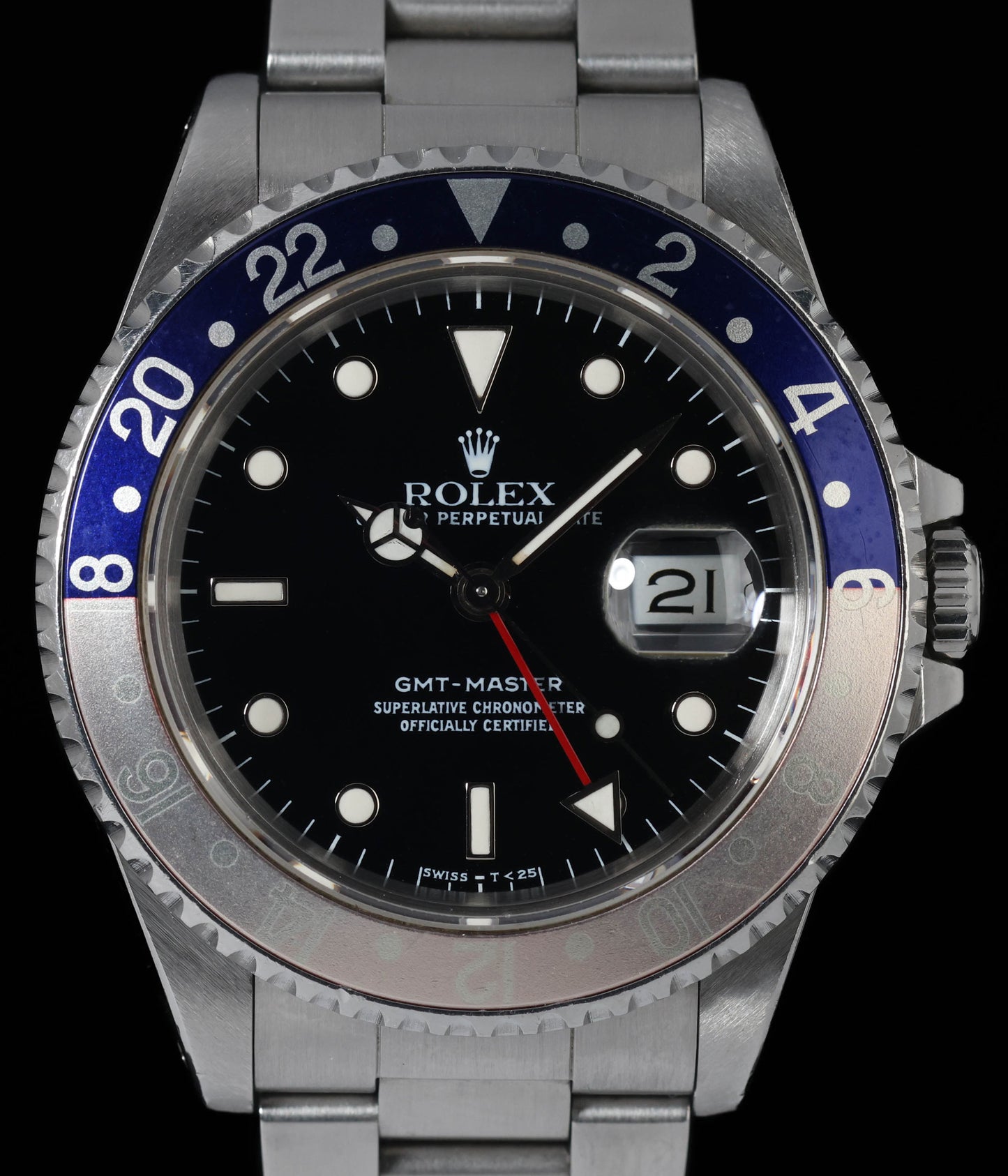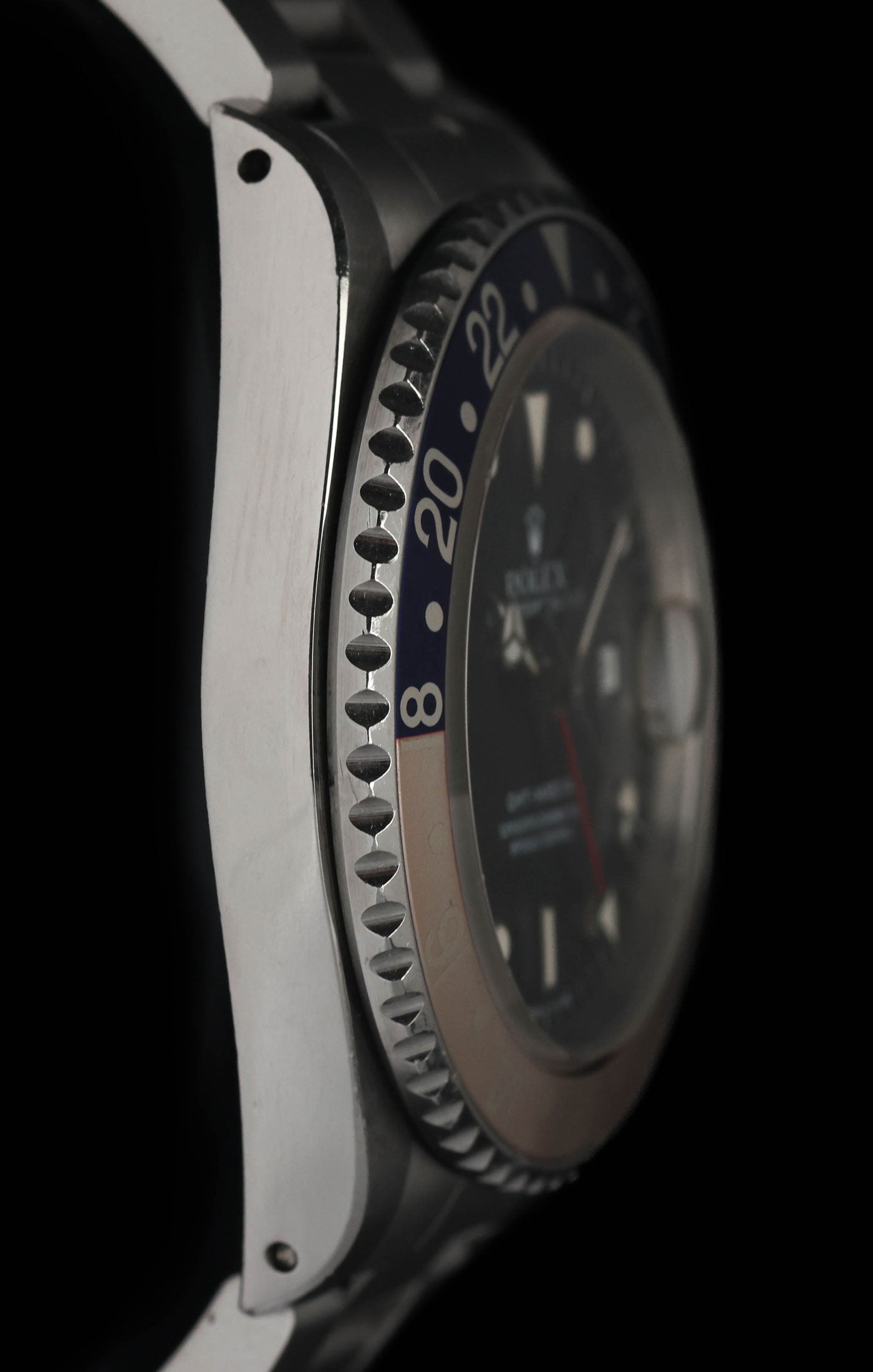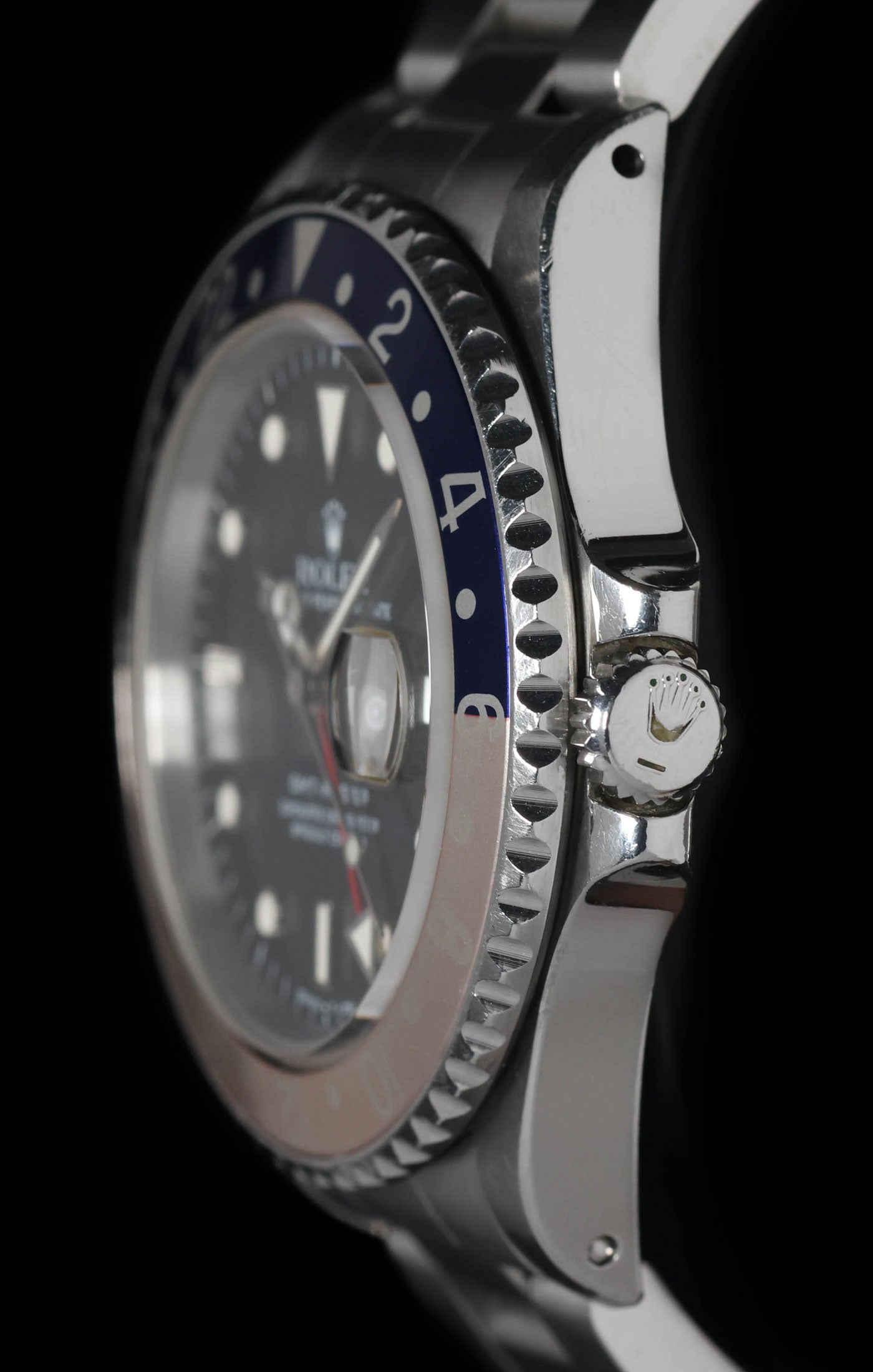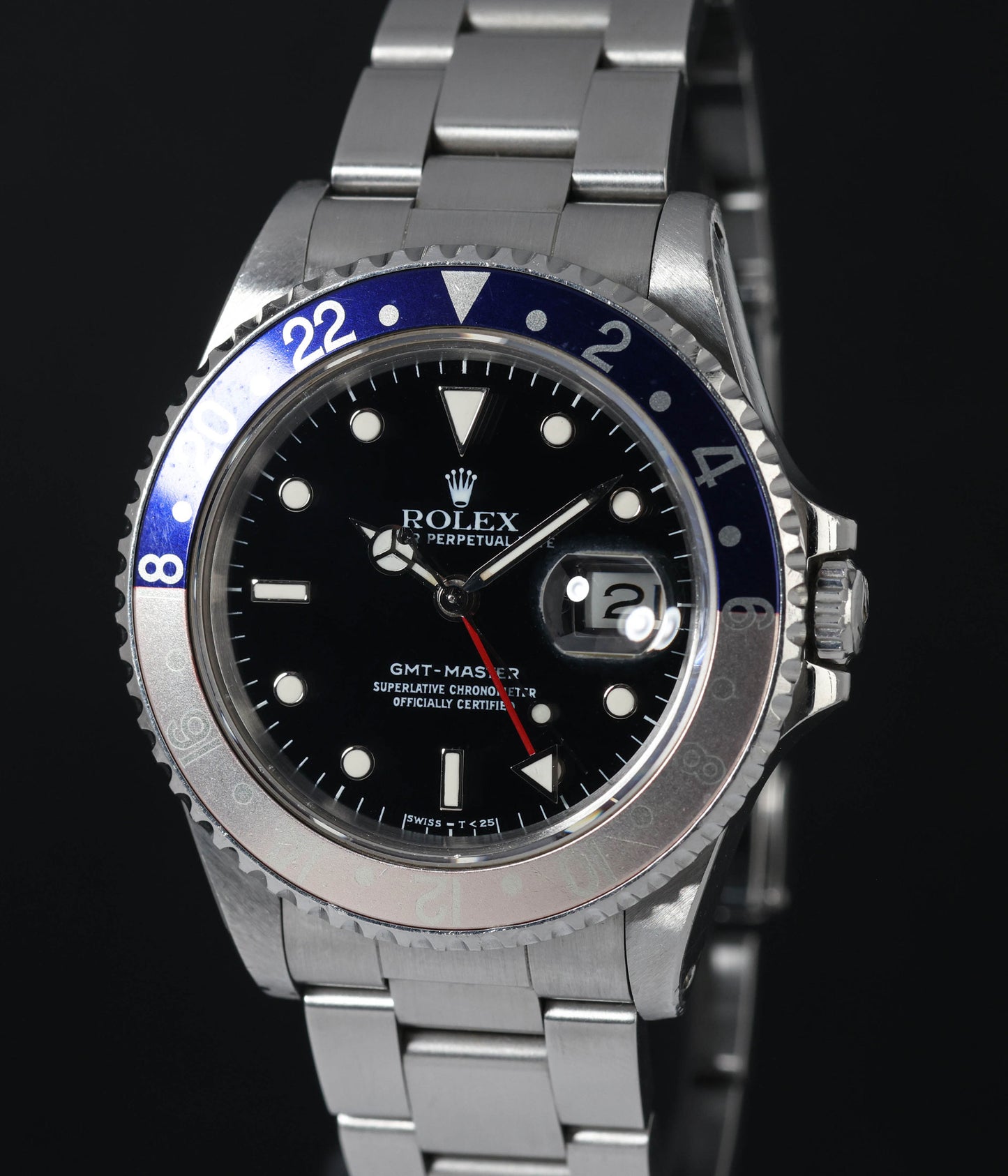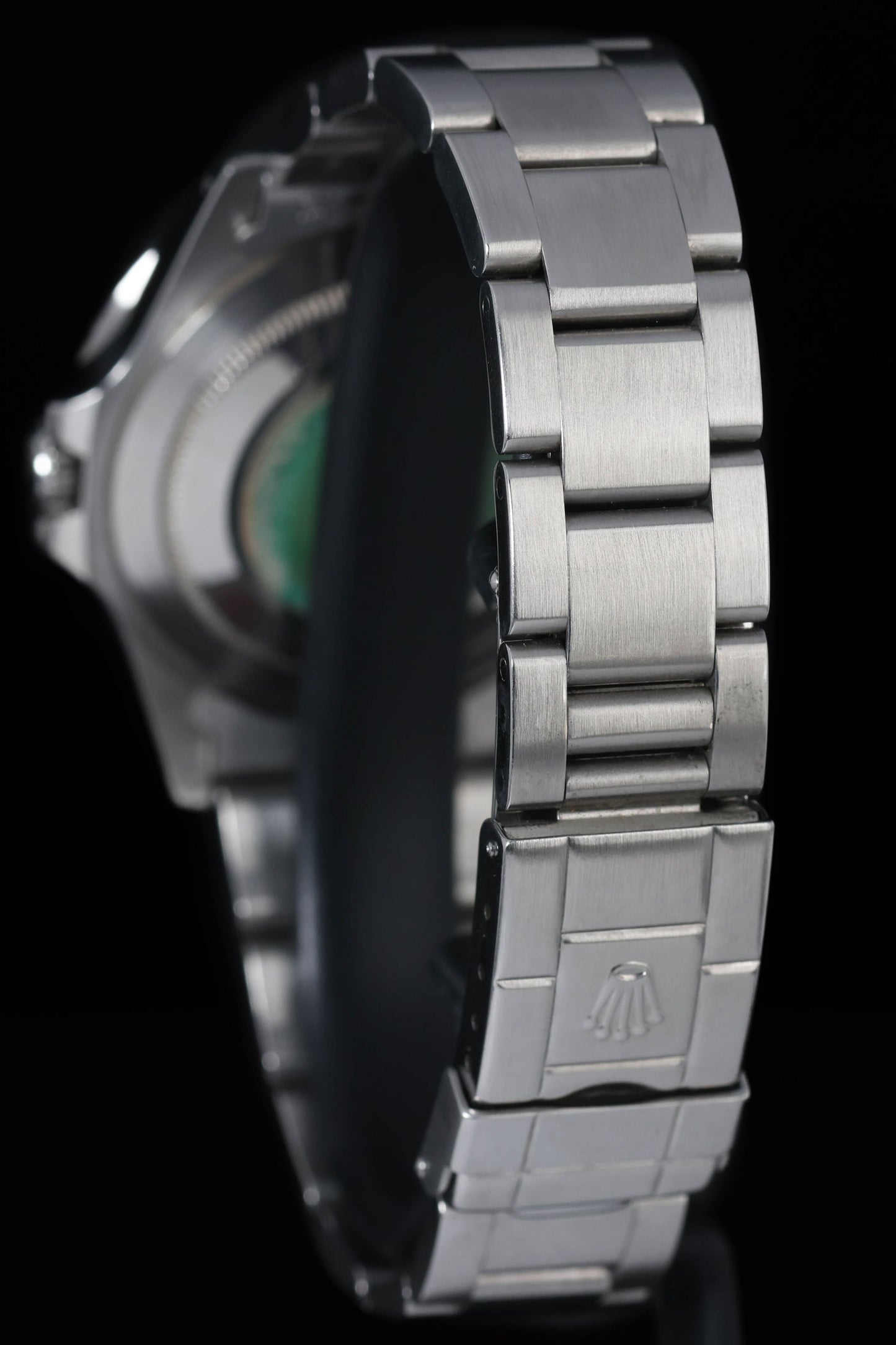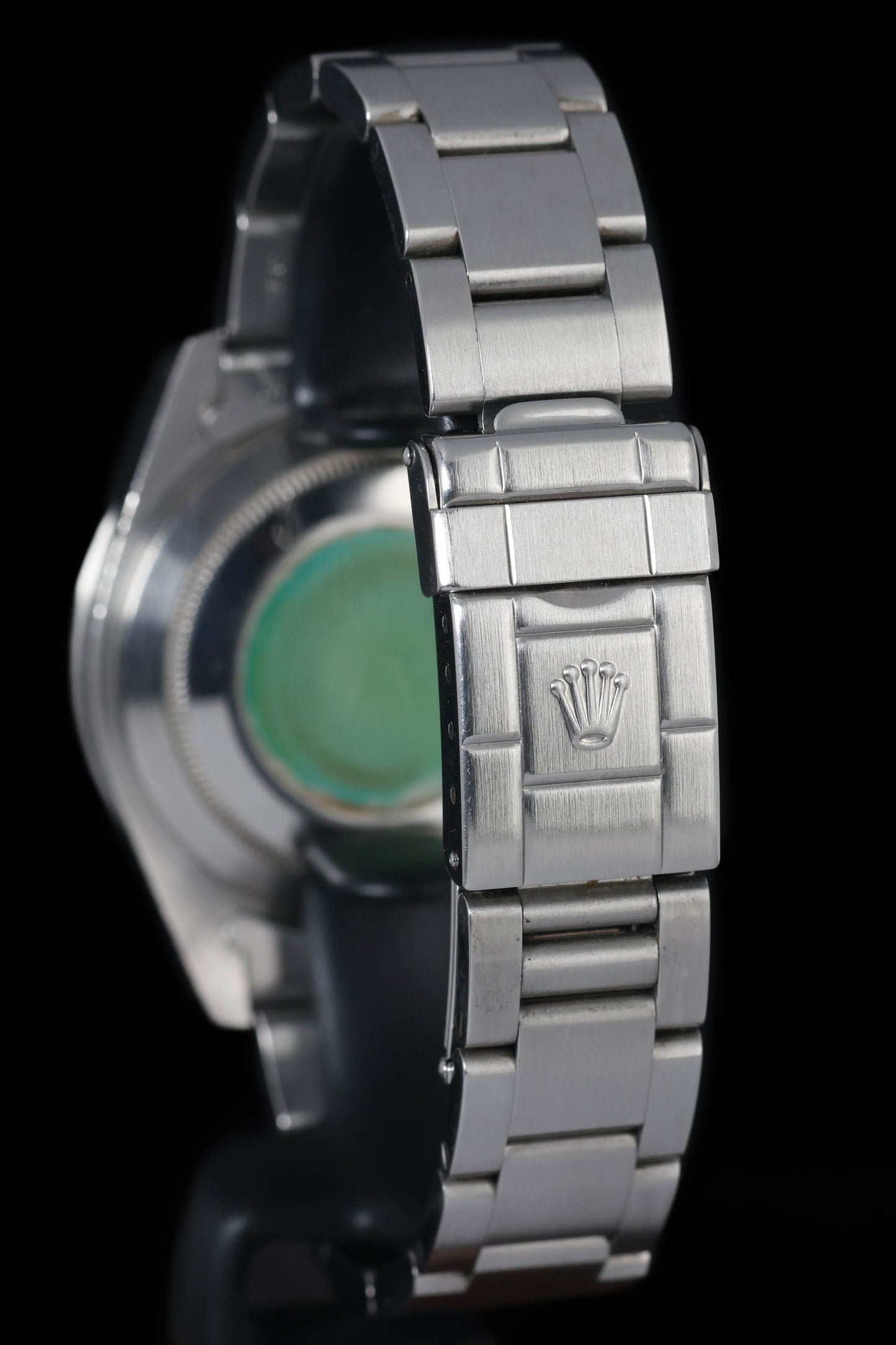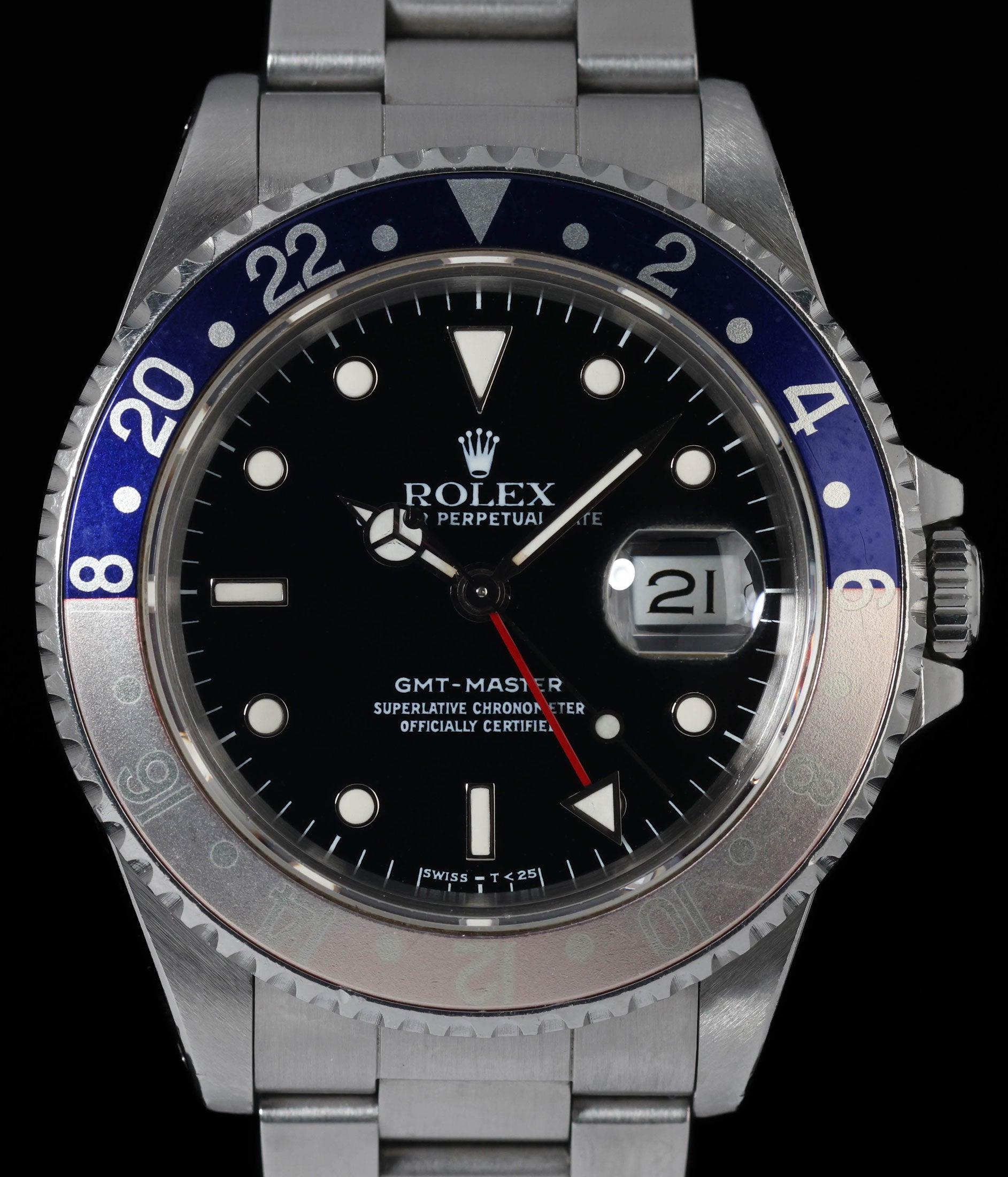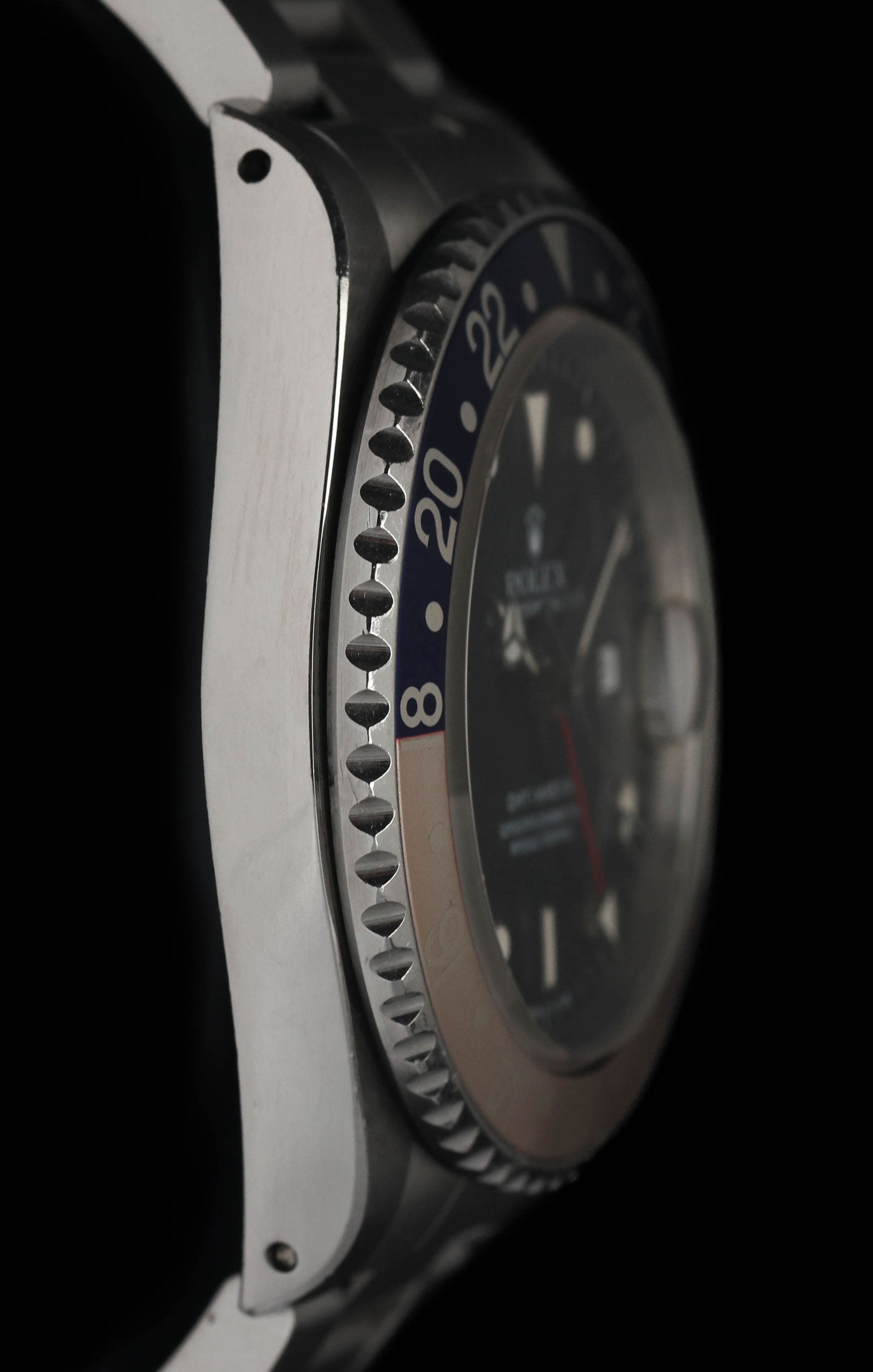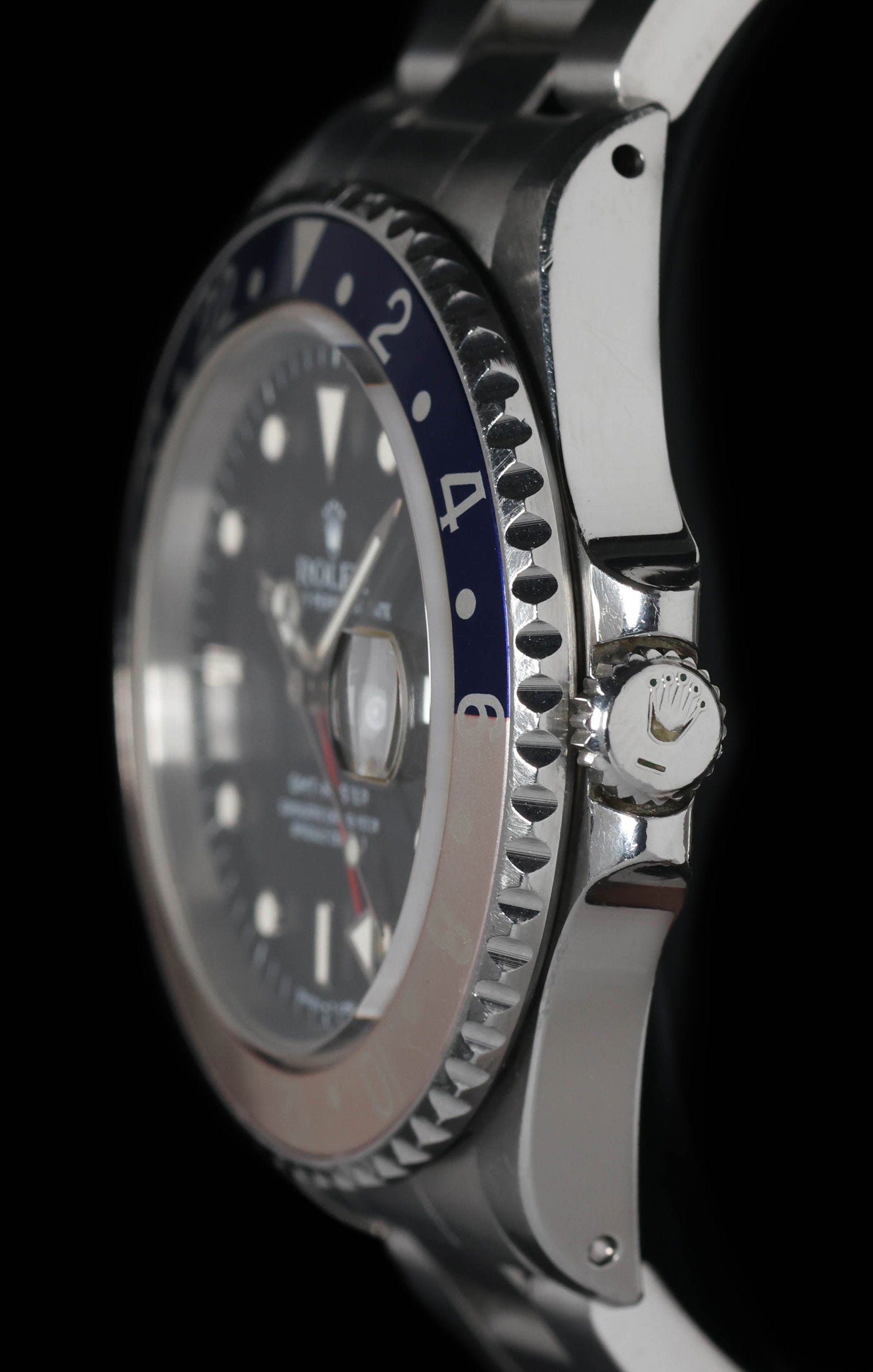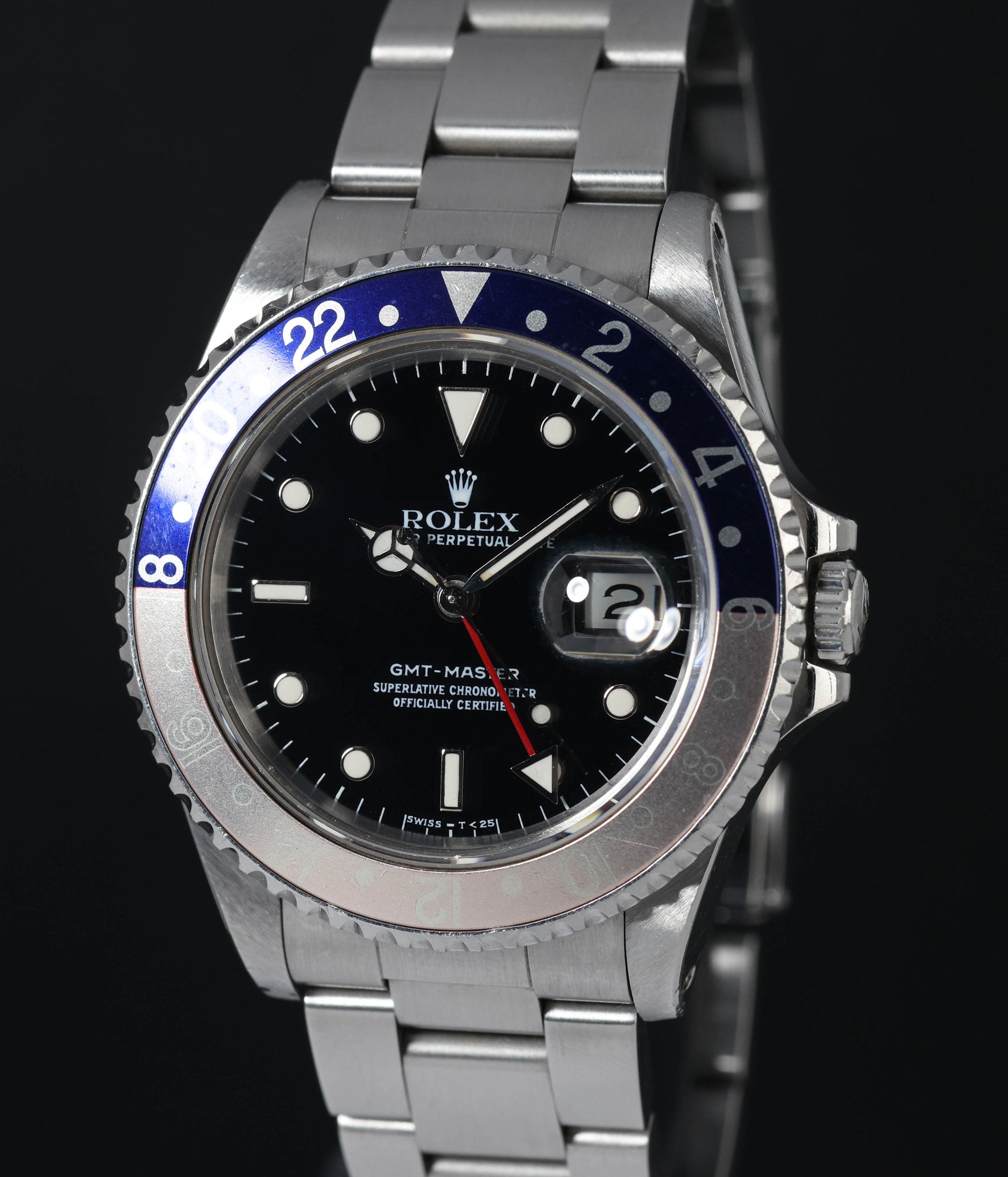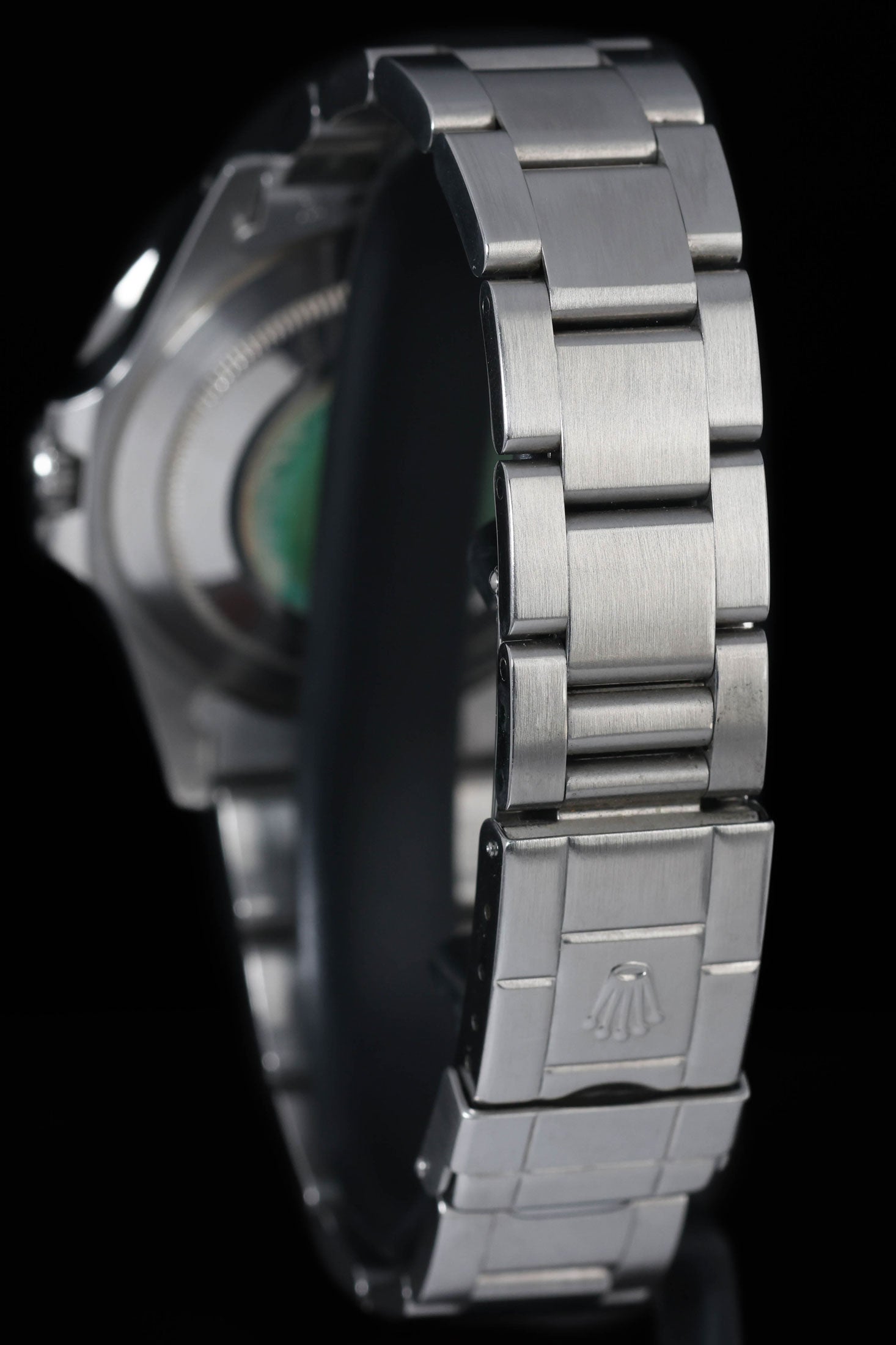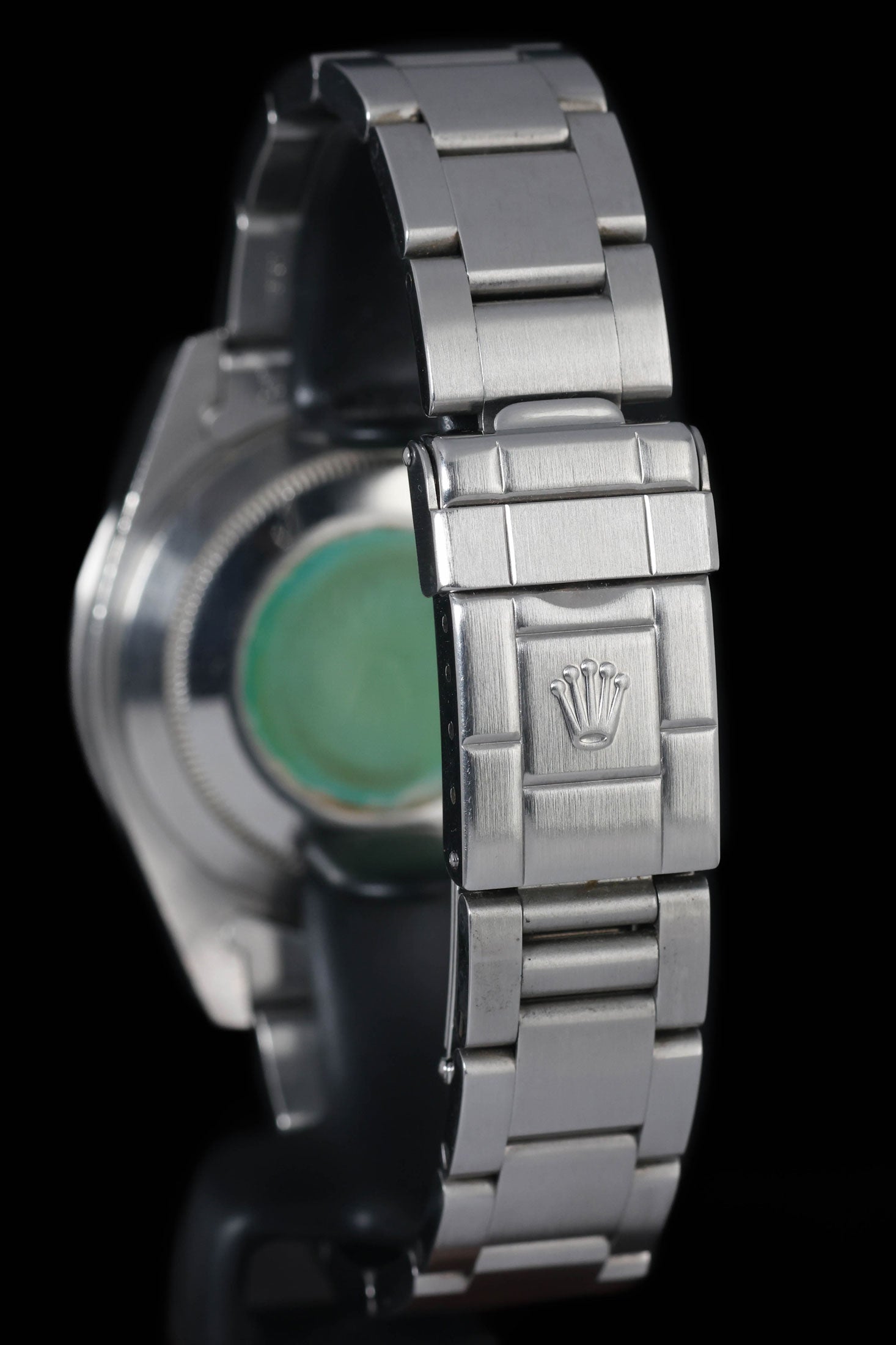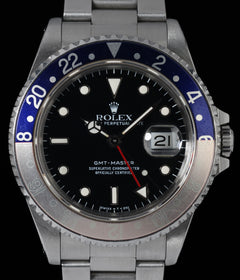Crown Vintage
Rolex GMT Master 16700 'Pepsi' Fat Font 40mm 1989
Rolex GMT Master 16700 'Pepsi' Fat Font 40mm 1989
Couldn't load pickup availability
Rolex GMT Master 16700 'Pepsi' Fat Font
Case is in excellent vintage condition with noticeable hairlines consistent with age. The lugs remain thick and well-defined, with no signs of over-polishing—case edges appear sharp and original. Bezel insert retains strong colour, with minor surface wear and light fading appropriate for its age.
The Oyster bracelet shows minimal stretch and remains secure on the wrist. Clasp functions as intended and end links fit flush to the case.
Dial presents an attractive mix of cream and deeper pumpkin-toned patina across the luminous plots, all intact. Hands match the dial lume and remain clean, free of corrosion and flaking. Acrylic crystal clear with only minor marks; crown screws down firmly and movement winds, sets and runs within expected tolerances.
As this is a 35-year-old watch, it should no longer be considered a dive instrument without appropriate servicing. While originally designed with 100m water resistance, it is recommended for dry wear.
Share
Why we love this watch
Why we love this watch
Rolex GMT-Master 16700 (1989): The Last of the Original GMTs
The Rolex GMT-Master 16700 holds a distinct place in the evolution of Rolex’s travel watch line-up. Introduced in 1988 and produced until 1999, it served as the final expression of the GMT-Master before the line fully transitioned into the GMT-Master II family. Our 1989 example hails from the early days of this reference and features a vibrant “Pepsi” bezel with the sought-after fat font insert—an aesthetic detail prized by collectors for its bold, period-correct character.
But beyond the bezel, the 16700 occupies a compelling space in the broader GMT narrative: modern enough for daily wear, yet classic enough to maintain that unmistakable vintage charm. To understand its significance, we need to trace the lineage back to the original Pan Am GMTs of the 1950s and follow its progression through the decades.
From Jet Age Origins to Late 1980s Refinement
The story of the GMT-Master begins in 1954 with the reference 6542, developed at the request of Pan Am to aid pilots flying across time zones. It introduced a fourth hand—rotating once every 24 hours—and a two-tone bezel insert that differentiated day from night. Over the next thirty years, Rolex evolved the GMT into the references 1675 and 16750, gradually refining materials, movements, and case construction.
By the late 1980s, the aviation industry had changed, but the appetite for a robust and legible dual-time watch had only grown. In 1988, Rolex introduced two new references: the GMT-Master II 16710, which allowed the hour hand to be set independently, and the GMT-Master 16700, which retained the more traditional design.
The 16700, then, is both a continuation and a farewell. It was the last GMT-Master to use a non-independent hour hand and the final model to carry the “GMT-Master” name alone before the line was entirely overtaken by the GMT-Master II.
Case and Bezel: Familiar Form, Evolving Detail
The 16700 retained the classic 40mm Oyster case design with drilled lugs and a lug-to-lug measurement of approximately 47mm. Crafted in stainless steel, it offered 100 metres of water resistance and a solid presence on the wrist without feeling oversized. The bezel was bidirectional—typical of the GMT-Master (in contrast to the click-spring mechanism of the GMT-Master II)—and featured the iconic red and blue aluminium insert.
Our 1989 example features an original “Pepsi” bezel insert with fat font numerals—a detail associated with earlier inserts used by Rolex throughout the 1980s. These numerals are wider, more rounded, and carry a vintage feel that later service inserts tend to lack. Over time, the anodised aluminium develops subtle fade, and no two are alike. Some lean towards pale magenta and sky blue, others deepen with character, depending on UV exposure and wear patterns. This particular insert has held its colour exceptionally well, showing only minor signs of age and wear.
Dial and Hands: Transitional Elements
One of the most intriguing aspects of the early 16700s is their use of tritium lume, visible via the “Swiss – T<25” marking at the bottom of the dial. Over time, tritium develops patina—ageing from stark white to tones of cream, custard, or pumpkin. Our 1989 example shows even ageing across both dial and hands, with no signs of reluming or replacement, giving it the cohesive look collectors appreciate.
The dial layout itself remained true to GMT form: applied white gold surrounds around each luminous hour plot, a triangle at 12, baton markers at 6 and 9, and a date window at 3 o’clock magnified by the Cyclops lens. Hands are traditional Mercedes-style, with a red 24-hour hand tipped in a matching triangular arrow. Despite the lack of an independently adjustable hour hand (a feature of the GMT-Master II), the watch still allows for dual-time functionality via the bezel and 24-hour hand.
It’s a dial that remains legible and balanced, avoiding the busyness that crept into some later references. There are no unnecessary flourishes, just clarity and function—a pilot’s tool turned daily companion.
Movement: Calibre 3175
Powering the GMT-Master 16700 is Rolex’s calibre 3175, an automatic movement based on the well-regarded 3135 but modified for GMT use. Introduced specifically for this reference, the 3175 features a quickset date and hacking seconds but lacks the independently adjustable hour hand of its 3185 sibling found in the GMT-Master II.
While this limits some flexibility for frequent flyers, it simplifies operation and offers fewer components, translating to slightly better long-term serviceability and reliability. Beating at 28,800 vibrations per hour with a 48-hour power reserve, the 3175 is a solid, workhorse calibre that remains respected among watchmakers and collectors alike.
Importantly, the 16700 was chronometer-certified, with each watch regulated to meet COSC standards. Despite being the simpler of the two GMT options at the time, Rolex didn’t skimp on precision.
Bracelet and Wearability
The watch came standard with the Oyster bracelet—reference 78360 or 93150—with hollow centre links and a folding clasp. Early 16700s also featured hollow end links and stamped clasps, giving them a lighter, more flexible feel on the wrist than later solid-link bracelets. That slight rattle is part of the charm, not a flaw.
With its 20mm lug width and relatively svelte case profile, the 16700 wears with understated ease. It hugs the wrist rather than dominating it. And while many vintage Rolex sports watches are being fitted to leather straps or NATO bands, there’s something satisfying about wearing the 16700 on its original steel bracelet. It was designed for it, and it shows.
Daily Use and Legacy
Despite its tool-watch origins, the GMT-Master 16700 holds its own as a modern daily wearer. The sapphire crystal makes it more scratch-resistant than its acrylic-dialled predecessors, and the automatic movement is both robust and easy to maintain. However, this is now a 35-year-old watch, and it should be treated as such. We do not recommend using it as a professional tool for diving or travel timing without a full service and pressure test from a qualified Rolex watchmaker.
Where it truly shines is in its blend of vintage charm and modern reliability. It lacks the bulk and reflective glare of ceramic GMTs and instead offers a quietly confident wrist presence. The bezel colours catch light in all the right ways. The case tucks neatly under a cuff. And the watch as a whole whispers history without shouting about it.
The 16700 vs. The 16710
The 16700 and 16710 were produced concurrently from 1988 through to 1999. While they appear nearly identical, there are meaningful distinctions. The 16710, being a GMT-Master II, offers the additional functionality of an independently set hour hand, allowing wearers to track three time zones instead of two.
But the simplicity of the 16700 appeals to a different kind of wearer—someone who values the lineage of the original Pan Am-era GMT, who prefers a watch that does just enough, without complexity for complexity’s sake. Its bezel is smoother, its movement slightly simpler, and its aesthetic more rooted in the past. It’s also marginally rarer, produced in smaller quantities than the 16710, especially in these early years.
For many collectors, the 16700 occupies the Goldilocks zone: more modern than a 16750, more wearable than a 16760 “Fat Lady,” and more balanced than the supercases of the 21st century.
Final Thoughts
The Rolex GMT-Master 16700 from 1989 is more than just a transitional model—it’s a considered evolution that remains truer to the GMT’s original ethos than many of its successors. This example, with its rich tritium dial, classic proportions, and striking fat font Pepsi insert, captures a moment when Rolex still made watches for professionals first and luxury buyers second.
Its significance lies in what it represents: the last of the original GMT-Masters, made for travellers before travel became a luxury. It’s a piece of the late 1980s captured in steel and aluminium, beating steadily on the wrist more than three decades later.
As modern GMTs grow larger, flashier, and more ornate, the 16700 offers a clean alternative—a reminder that function, form, and heritage can still coexist in a single reference. For those seeking a vintage Rolex GMT that still flies slightly under the radar while delivering daily practicality, the 16700 might just be the perfect layover between past and present.
Case & Bracelet
Case & Bracelet
- Case excellent vintage condition. Noticeable hairlines around the case.
- Case appears unpolished
- Bracelet has minimal stretch
Dial & Hands
Dial & Hands
- Dial & hands in great condition.
Warranty & Condition
Warranty & Condition
Crown Vintage Watches provides a minimum 3-month mechanical warranty on pre-owned watches, from the date of purchase.
The warranty covers mechanical defects only.
The warranty does not cover damages such as scratches, finish, crystals, glass, straps (leather, fabric or rubber damage due to wear and tear), damage resulting from wear under conditions exceeding the watch manufacturer’s water resistance limitations, and damage due to physical and or accidental abuse.
Please note, water resistance is neither tested nor guaranteed.
Shipping and insurance costs for warranty returns to us must be covered by the customer. Returns must be shipped via traceable courier. Return shipment must be pre-paid and fully insured. Collect shipping will be refused. In case of loss or damages, the customer is liable.
Our Pledge
At Crown Vintage Watches, we stand by the authenticity of every product we sell. For added peace of mind, customers are welcome to have items independently authenticated at their own expense.
Condition
Due to the nature of vintage timepieces, all watches are sold as is. We will accurately describe the current condition and working order of all watches we sell to the best of our ability.
Shipping & Refund
Shipping & Refund
